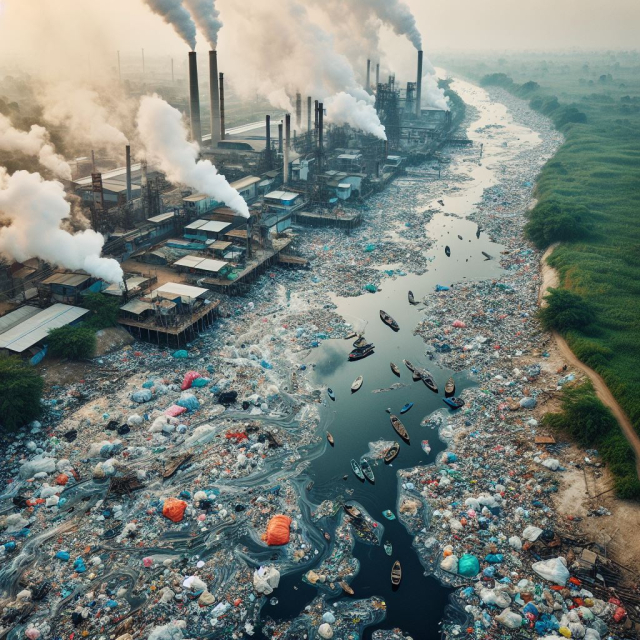Managing water pollution and preserving water resources are critical issues in Ecuador, a country known for its rich biodiversity and its dependence on water sources for human consumption, agriculture, industry and wildlife. Over the past decades, Ecuador has faced numerous challenges related to water pollution, ranging from industrial and agricultural pollution to deforestation and uncontrolled urbanization. In this article, we will explore in detail how Ecuador is addressing these challenges, the strategies it is implementing to manage water pollution and protect its water resources, and the obstacles it faces in this process.
The Importance of Water in Ecuador.
Water is an invaluable resource in Ecuador, a country that is home to a variety of ecosystems, from the Amazon rainforest to high mountain paramos and Pacific coasts. Water is vital for the survival of flora and fauna, as well as for the health and well-being of the human population. Additionally, water plays a crucial role in the country's economy, as it is essential for agriculture, hydroelectric power generation, tourism and other industries.
Water Pollution Challenges in Ecuador.
Despite the importance of water, Ecuador faces a series of challenges related to water pollution:
Industrial contamination:
Industry is a major source of water pollution in Ecuador, with industrial waste discharges contaminating rivers and bodies of water throughout the country. Industries such as mining, manufacturing, and food processing can release a variety of contaminants, including heavy metals, toxic chemicals, and organic wastewater, which can have adverse effects on water quality and human health.
Agricultural Pollution:
Agriculture is another significant source of water pollution in Ecuador, with the use of pesticides, fertilizers and other chemicals that can contaminate surface and groundwater. Agricultural runoff can transport nutrients and chemicals from fields to bodies of water, causing problems such as eutrophication and harmful algal blooms.
Deforestation and Soil Erosion:
Deforestation and soil erosion are important factors contributing to water pollution in Ecuador. Clearing forests and converting forest land to grasslands and crops increases soil erosion and runoff, which can lead to river sedimentation and loss of aquatic habitat.
Urbanization and Unplanned Development:
Unplanned urban growth and lack of adequate wastewater treatment infrastructure are common problems in many cities and urban areas of Ecuador. Raw wastewater is discharged directly into rivers and streams, contributing to water pollution and putting public health at risk.
Water Pollution Management Strategies in Ecuador.
Faced with these challenges, Ecuador is implementing a series of strategies to manage water pollution and protect its water resources:
Environmental legislation:
Ecuador has environmental laws and regulations aimed at protecting water quality and preventing pollution. These laws establish water quality standards, regulate industrial and agricultural activities, and establish penalties for those who contaminate water resources.
Monitoring and Surveillance:
Monitoring and surveillance of water quality are essential to identify sources of pollution and evaluate the status of water resources throughout the country. Ecuador has water quality monitoring networks that collect data on parameters such as contaminant concentration, turbidity, and pH in different bodies of water.
Sewage treatment:
Wastewater treatment is a priority in water pollution management in Ecuador. The country is investing in the construction and improvement of wastewater treatment plants in urban and rural areas to reduce the load of pollutants discharged into water bodies.
Ecosystem Conservation:
Conservation of ecosystems such as forests, wetlands and mangroves is an effective strategy to protect water quality and maintain the health of water resources. These ecosystems act as natural filters that can reduce water pollution and regulate water flow in landscapes.
Education and Awareness:
Environmental education and public awareness are key components of water pollution management in Ecuador. Through information campaigns and environmental education programs, we seek to raise awareness among the population about the importance of protecting water resources and promoting sustainable water use practices.
Challenges and Opportunities in Water Management in Ecuador.
While Ecuador has made progress in managing water pollution, it still faces a number of challenges and opportunities on this front:
Challenges:
- Financing: The lack of financial resources is a major obstacle to the implementation of water pollution management measures in Ecuador.
- Inter-institutional Coordination: Improving coordination between different government institutions and interested actors is essential to comprehensively address water pollution problems.
- Climate Change: Climate change can aggravate water pollution problems in Ecuador, increasing the frequency and intensity of extreme weather events and affecting the availability and quality of water.
Opportunities:
- Technological Innovation: Innovation in wastewater treatment and water quality monitoring technologies can provide opportunities to improve water pollution management in Ecuador.
- International Collaboration: Cooperation with international organizations and neighboring countries can provide opportunities to access financing, technical knowledge and best practices in water management.
- Community Participation: Involving local communities in decision-making and implementation of water management projects can strengthen response capacity and resilience to water pollution challenges.
The management of water pollution and the preservation of water resources are critical issues in Ecuador, a country with rich biodiversity and a strong dependence on water for multiple uses. While Ecuador faces significant challenges on this front, it also has a number of strategies and opportunities to improve water management and protect its water resources for future generations. By continuing to invest in wastewater treatment infrastructure, ecosystem conservation, environmental education and international cooperation, Ecuador can move towards more sustainable and resilient water management and ensure equitable access to clean and safe water for all its inhabitants.
